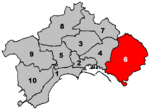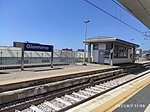Barra (Naples)
Barra is an eastern quarter of Naples, southern Italy, with a population of some 40,000 inhabitants (38,103 in the 2001 census.) Barra occupies the easternmost section of the Naples comune's territory, ranging from the sea to the Vesuvio's slopes, bounding with Poggioreale. The area has suffered much the same fate of urban decay as the rest of the eastern periphery of Naples, a fate that includes drugs and entrenched organized crime. Historically, it was one of the Vesuvian areas built up under the Bourbons in the 18th century and still displays some structures from that period that have been restored and incorporated into the tourist/cultural itinerary of "Vesuvian Villas". The area was heavily bombed in World War II.
Excerpt from the Wikipedia article Barra (Naples) (License: CC BY-SA 3.0, Authors).Barra (Naples)
Via Domenico Atripaldi, Naples Barra
Geographical coordinates (GPS) Address Nearby Places Show on map
Geographical coordinates (GPS)
| Latitude | Longitude |
|---|---|
| N 40.833333333333 ° | E 14.316666666667 ° |
Address
Via Domenico Atripaldi
Via Domenico Atripaldi
80146 Naples, Barra
Campania, Italy
Open on Google Maps











